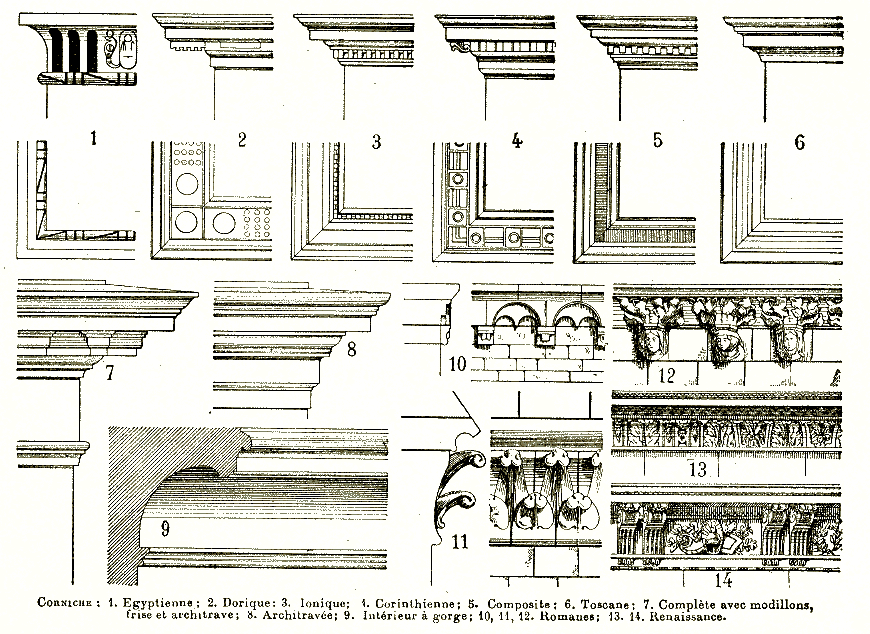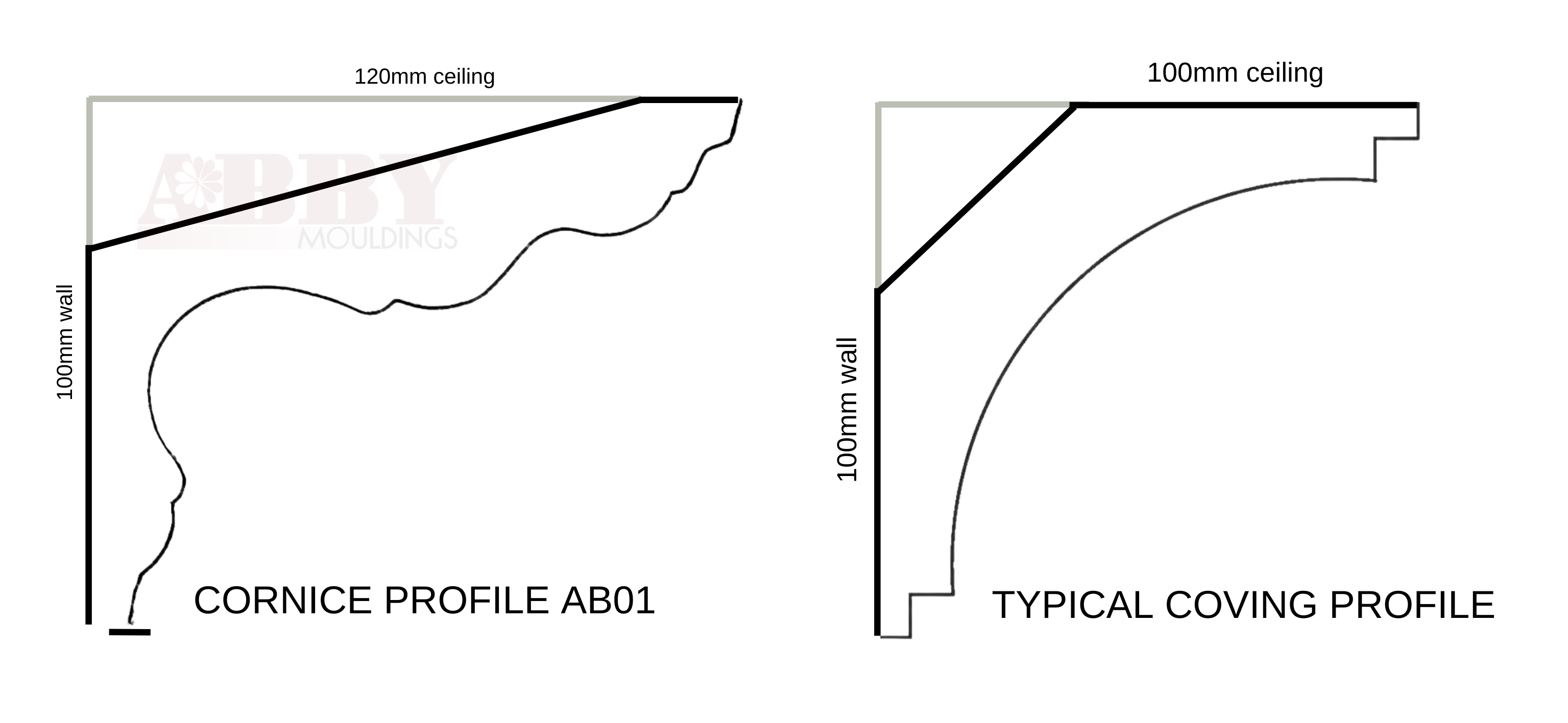A cornice is an architectural detail that extends beyond the surface it rests on. It serves as a prominent horizontal feature that protrudes over a wall or below a roofline. In ancient Greek and Roman structures, the cornice played a significant role as the crowning part of the entablature. It is traditionally composed of various components:
- Cyma: This is a distinctive moulding characterised by its double curvature, often referred to as a ‘wave moulding.’ It occupies the highest position within the cornice and can take the form of either a cyma rectum (with an upper concave curve and a lower convex curve) or a cyma reversa (with an upper convex curve and a lower concave curve).
- Corona: This particular component features a vertical face and a horizontal soffit, contributing to the overall structure.
- Bed-moulding: Positioned beneath the projecting cornice, the bed-moulding is a moulding that adds a final touch to the appearance.
While the primary function of cornices is to protect the walls of a structure by diverting rainwater away, they also hold significant decorative significance. Beyond their practical role, cornices find widespread use in interior design. They act as a type of moulding running along the top of interior walls, serving multiple purposes. By reflecting light into shadowy areas, they can illuminate a room and create a brighter ambiance. Moreover, they have the ability to visually expand small spaces by drawing attention upward. Additionally, they can be used to conceal any unsightly cracks that may occur along the joints between walls and ceilings.

Cornice or Coving: The difference between traditional plaster cornice and modern coving products.
Have you ever been guilty of using the term astroturf when discussing artificial grass? Surprisingly, AstroTurf is not just a generic term but an actual brand name that has gained widespread popularity, much like other household brands.
For instance, we often use the term “Hoover” to refer to any vacuum cleaner, regardless of the brand. How many of us say “I’m going to Hoover” instead of “I’m going to vacuum”? Similarly, the same phenomenon can be observed with coving. The prevalence of cheap, mass-produced paper-coated strips sold by various DIY stores and builder’s merchants has resulted in most cornices being referred to as coving. However, it’s important to note that there is a significant distinction between the two.
Authentic cornice is meticulously crafted by skilled artisans using traditional plaster materials and techniques. Here at Abby Mouldings, we take pride in manufacturing cornices of the highest quality within our own Devon workshop, employing time-honoured methods. Originally, coving denoted the gracefully curved profile or shape of the cornice, often referred to as a cavetto, which resembles a quarter sphere. This visual can be likened to the shape of a cove on a coastal map. True coving possesses a uniform shape and size, typically protruding 100mm from the corner across the ceiling and extending 100mm down the wall, presenting an elegant concave form.
What sets cornice apart from coving?
When discussing artificial grass, we often throw around the term Astroturf, even though it is just one brand among many. Similarly, Hoover has become synonymous with vacuum cleaners, regardless of the actual brand. We tend to say, “I’m going to Hoover” instead of “I’m going to vacuum.” A similar trend has emerged with coving. The proliferation of cheap, mass-produced paper-coated strips in DIY stores and builder’s merchants has led to the misconception that all cornice is coving. However, there is a significant distinction to be made.
True cornices are meticulously crafted by skilled artisans using traditional plaster materials and techniques. Here at Abby Mouldings, we take pride in manufacturing cornices using these time-honoured methods in our very own workshop in Devon. Originally, coving referred to the consistent curved profile or shape of the cornice, known as a cavetto, which resembles a quarter sphere. This visual can be likened to the contour of a cove on a map. Coving typically maintains a uniform shape and size, protruding 100mm from the corner along the ceiling and extending 100mm down the wall with a consistent concave form.

A typical coving profile along with a more ornate cornice profile
Following the war, this particular style of basic coving gained immense popularity due to its affordability and widespread production in gypsum plaster. As it became easily accessible and a prominent fixture in countless households during this era, the term “coving” became ingrained in the common lexicon, encompassing various kinds of mouldings utilised in a similar manner. Whether they were modest, factory-made designs or grand, intricate patterns, they all fell under the umbrella of this household name.

Dentil-style plaster cornice
In addition to being crafted by skilled artisans using premium plaster and traditional materials, cornice stands out for its grandeur and intricate design compared to ordinary coving. This is evident in numerous historical and period properties today, where cornice takes the form of exquisite dentil and egg and dart styles influenced by ancient Greek and Roman architecture, as well as bold, geometric patterns popular during the Art Deco era.
It’s important to note that while coving is a commonly used term in contemporary language, some of the cornice featured on our website may be referred to as coving. Rest assured, all of our cornice is meticulously crafted by our talented craftsmen in Devon, employing the same traditional methods and materials used throughout history.
Hand-crafted cornices by Abby Mouldings
Abby Mouldings proudly holds its position as the premier authority in the art of crafting and installing exquisite plaster cornices in the enchanting region of Devon. Our vast expertise allows us to flawlessly bring to life a diverse range of designs, from the majestic Victorian to the invigorating contemporary. When you entrust your project to our dedicated team, rest assured that nothing less than perfection will be achieved.
Should you possess a specific vision for your space, our highly skilled craftsmen are eager to engage in detailed discussions, ensuring that every plaster moulding is meticulously tailored to your precise specifications. Moreover, if your project calls for the restoration of broken plaster cornices in Devon, our unparalleled ability to replicate the existing design with remarkable accuracy is at your disposal. Conveniently located in Newton Abbot, our services extend beyond Devon, catering to customers in Cornwall, Somerset, and even farther afield, if required.
At Abby Mouldings, our cornices are meticulously handcrafted by a team of skilled artisans, utilising traditional techniques and authentic plaster materials. Within our esteemed workshop, nestled in the picturesque county of Devon, we take the utmost care to ensure that each cornice is crafted with unparalleled precision and dedication. Setting ourselves apart from traditional coving, our cornices command attention with their impressive size and intricate ornamental details. Be it the resplendent dentil or the timeless egg and dart-style cornices, our designs pay homage to the architectural grandeur of ancient Greek and Roman civilisations.
Additionally, our collection showcases bold and robust geometric cornices, reflecting the captivating aesthetics of the Art Deco era. These magnificent cornices grace numerous heritage and period properties, infusing their interiors with an enduring elegance that transcends time.

Buy Online with Confidence
Our products are manufactured using the highest quality materials and traditional techniques, methods and plasters, hessian and timber lathes by our master craftsmen so you can be assured of receiving the highest quality products.

Restoration Specialists
For over 30 years Abby Mouldings have been proudly restoring, manufacturing and fitting quality plaster mouldings for domestic and commercial period, listed and heritage properties across Devon, Cornwall, Somerset and beyond.

Traditional Plastering Services
Our plastering service includes all types of internal wall and ceiling plaster, external plastering including lime plaster, ceiling repair and restoration of heritage ceilings including strapwork and ornate plaster ceilings and insurance work.
